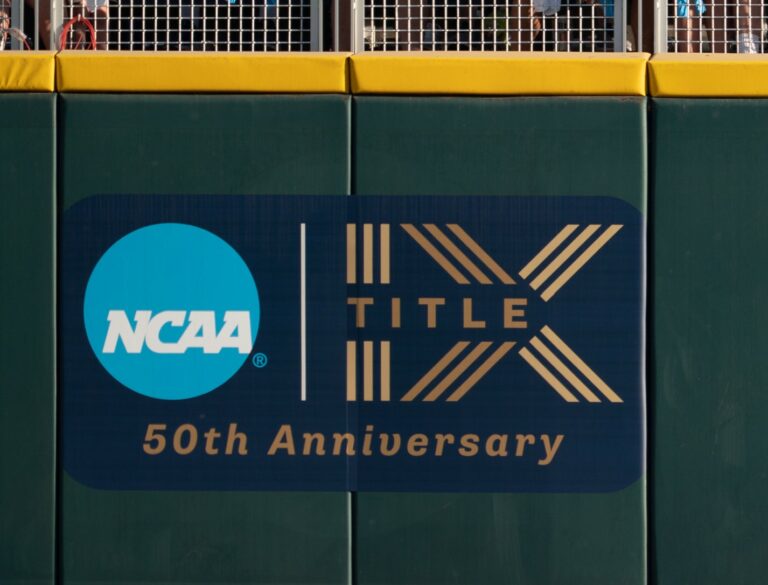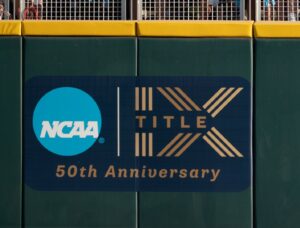What is Title IX?

Title IX refers to a specific provision of the federal Education Amendments Act of 1972. The provision, which celebrates its 50th anniversary this year, states simply: “No person in the United States shall, on the basis of sex, be excluded from participation in, be denied the benefits of, or be subjected to discrimination under any education program or activity receiving Federal financial assistance.”
The stated intention of the law was to provide men and women equal access to opportunities offered by institutions that receive federal government funding.
Equal access has since been construed broadly, to include not just access to scholarships, athletics, and extracurriculars, but also the right to be free from discrimination based on pregnancy or parenthood, and protections against sexual violence and retaliation. Any institutional practice that makes it harder for women to be included, for example, could therefore be targeted as a Title IX violation.
What has been the Impact of Title IX?
In 1972—when Title IX became law—57 percent of college students were men and 43 percent were women. But the more selective the education, the fewer women were admitted or included. Women earned only 7 percent of law degrees and 9 percent of medical degrees. Women’s sports garnered just 2 percent of university spending on athletics. Women were not eligible for admission to some Ivy League schools and were excluded from prestigious scholarships and awards.
Things couldn’t be more different today. In the spring 2022 freshman undergraduate class, more than 50 percent of incoming students nationwide were women. Women now earn a higher percentage of total university degrees than do men, including more PhDs, and women currently outnumber men in law school and medical school.
It’s hard to isolate the proportion of increased opportunities for women that directly resulted from Title IX versus the general societal movements and changes around women’s advocacy that began in the 1970s, but whatever the mix, opportunities for women are undoubtedly greater today than 50 years ago.
How is Title IX enforced?
For a clause just 37 words long, Title IX has become surprisingly complex.
Title IX applies to 16,500 local school districts; 7,000 post secondary schools; and charter schools, vocational training centers, libraries, and museums. The only enforcement mechanism implied by the original text of the law is the withdrawal or withholding of federal funds if a program doesn’t comply.
Title IX is mainly enforced by the Office for Civil Rights (OCR), a division of the Department of Education (DOE), which directs compliance in the form of “Dear Colleague” letters and investigation of complaints filed with the DOE.
Because of a 1975 regulation (34 C.F.R. 106.8) that required recipients of federal funds to delegate a responsible employee to handle Title IX compliance, universities and other institutions that fall under Title IX employ “Title IX Coordinators” to ensure compliance with the alleged spirit as well as the letter of the law. Many major universities have as many as 50 compliance staffers, sometimes called “sex equity officers.” In other words, mini-bureaucracies within each institution regulate suspected inequity, favoritism, discrimination, or impropriety on the basis of sex.
How does Title IX relate to sports?
Data has shown the remarkable benefits student athletes enjoy. Student athletes experience higher social, financial, and physical well-being levels because of their ability to compete. But for many years, limited opportunities and discrimination prevented many female athletes from participating and competing. This made athletics a particular focus of Title IX enforcement. Federal regulations implementing Title IX require any school sponsoring athletics to ensure women and men are provided equal opportunities to participate, which includes consideration of sponsored teams, as well as available coaching, equipment, and facilities, among other things.
The sports or programs offered by any particular school do not have to be identical or segregated by sex: Many schools with field hockey and volleyball teams do so only for women, and women as well as men are welcome to attempt to join the football team, for example. Schools are thus free to match their offerings with the interests of their students and communities. That’s why, for instance, there are 12 NCAA Division I hockey programs for men and women in Minnesota, but none in California.
Have there been downsides to Title IX?
While the years following Title IX’s enactment have seen tremendous gains in opportunity and participation, many government bureaucrats and school officials have interpreted the law to put some students and staff at a distinct disadvantage.
Title IX’s protections rightfully strengthened support for reporting sexual harassment on campus. Such cases are taken much more seriously now, but sometimes so much so that due process for the accused has been neglected. In attempting to make victims safe from harassment or retaliation, accused parties (usually men) have been disciplined or expelled unfairly, without a chance to dispute evidence or confront an accuser.
Also, while Title IX undoubtedly increased the number of athletic opportunities for female athletes, it decreased the number of athletic opportunities for male athletes—especially in non-profit-generating sports. Since 1988, more than 300 men’s Division I teams have been cut nationwide. That’s why men’s wrestling and gymnastics programs have dwindled, for example.
Purported budget concerns have led to some of these men’s teams being cut, but many are also because of a gross misinterpretation of Title IX law. In 1979, the Department of Education issued a non-binding “Policy Interpretation” instructing colleges and universities that one way they could comply with Title IX’s equal opportunity mandate was to show that their ratio of male and female athletes was “substantially proportionate” to their ratio of male and female undergraduates. In other words, if a school’s enrollment is 45% female, but its athletic programs is only 35% female, the resulting 10% underrepresentation may place the school at risk of OCR finding it in violation of Title IX. Unfortunately, this non-binding interpretation has since become the de facto method schools use to show Title IX compliance, ignoring other, more inclusive methods of ensuring equal opportunity. In effect, many schools now use sex-based quotas to cap the number of males or females participating in sports.
For example, Evan Ng is a talented young gymnast who, as a high school regional champion, had his choice of colleges. NCAA Division I schools came courting. Evan chose the University of Minnesota and promptly joined the men’s gymnastics team. Just a year later, the U of M announced plans to eliminate the entire men’s gymnastics program. Why? Women’s share of total undergraduate enrollment at the U of M had grown, causing the percentage of women participating in sports at Minnesota to fall slightly short of the percentage of female undergraduates. Administrators (incorrectly) claimed this disparity would cause it to run afoul of Title IX unless it reduced its number of male athletes.
Evan is suing the university (represented pro-bono by PLF) to see his team and his college athletic career restored. Shuttering sports programs because too many male athletes participate, or even that too few men are on campus, is exactly what Title IX prohibits: limiting students’ opportunities on the basis of sex.
How should we view Title IX moving forward?
Title IX proposed an end to sex-based discrimination and brought on a new dawn of equal opportunity. Since its passage, educational attainment by women has exploded. By reducing discrimination in all aspects of institutional life—housing, coursework, activities, employment—universities have given millions of young people a richer institutional experience.
That richness, free from discrimination, was the spirit of Title IX. A student’s sex should not be a barrier to achieving individual potential.
But the messiness of enforcing Title IX under constant threat of lawsuits and ever-more new bureaucratic directives twisted Title IX’s original spirit into its own enemy. The use of quotas, as well as manipulation of programs to ensure quota compliance, creates exactly the kind of injustice Title IX made progress in reducing.
Guidance from Congress and the courts about the parameters of Title IX enforcement, good-faith interpretation of Title IX policies, and common-sense application by school administrators are key to maintaining and building the legacy of this law. But more importantly, rather than viewing equal opportunity through the lens of number-crunching—a process that results in treating students as mere numbers on a ledger—institutions should instead return to the animating force behind Title IX: removing barriers and ensuring everyone has an equal opportunity to participate. Only then will taxpayer-funded institutions offer a full experience to all, regardless of sex.






